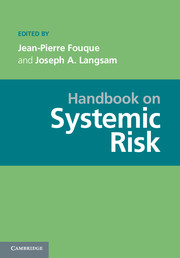Book contents
- Frontmatter
- Contents
- Contributors
- Introduction
- PART I DATA: THE PREREQUISITE FOR MANAGING SYSTEMIC RISK
- PART II STATISTICS AND SYSTEMIC RISK
- PART III MEASURING AND REGULATING SYSTEMIC RISK
- PART IV NETWORKS
- PART V SYSTEMIC RISK ANDMATHEMATICAL FINANCE
- PART VI COUNTERPARTY RISK AND SYSTEMIC RISK
- PART VII ALGORITHMIC TRADING
- PART VIII BEHAVIORAL FINANCE: THE PSYCHOLOGICAL DIMENSION OF SYSTEMIC RISK
- PART IX REGULATION
- PART X COMPUTATIONAL ISSUES AND REQUIREMENTS
- PART XI ACCOUNTING ISSUES
PART II - STATISTICS AND SYSTEMIC RISK
Published online by Cambridge University Press: 05 June 2013
- Frontmatter
- Contents
- Contributors
- Introduction
- PART I DATA: THE PREREQUISITE FOR MANAGING SYSTEMIC RISK
- PART II STATISTICS AND SYSTEMIC RISK
- PART III MEASURING AND REGULATING SYSTEMIC RISK
- PART IV NETWORKS
- PART V SYSTEMIC RISK ANDMATHEMATICAL FINANCE
- PART VI COUNTERPARTY RISK AND SYSTEMIC RISK
- PART VII ALGORITHMIC TRADING
- PART VIII BEHAVIORAL FINANCE: THE PSYCHOLOGICAL DIMENSION OF SYSTEMIC RISK
- PART IX REGULATION
- PART X COMPUTATIONAL ISSUES AND REQUIREMENTS
- PART XI ACCOUNTING ISSUES
Summary
Statistics and Systemic Risk
Statistical methods have long played a critical role in quantifying the risks inherent in various activities and they will undoubtedly continue to play an important role going forward. The challenge with regards to using statistical methods to quantify system-wide risks, inherent in a financial system, is that the use of historical, transaction data only allows for the calibration of reduced form models. These models assume that the system is stable and that structural changes (dramatic changes in resources or incentives of the participants are stable over time). As we know, the underlying structure of the financial system can change dramatically, especially during times of stress.
To illustrate this difference, consider the challenge of modeling foot traffic at an indoor shopping mall, where individuals have to pay to enter and exit one of the many mall doors. To model the movement of shoppers, we could build a purely statistical (reduced form) model of the door traffic, and for most situations this would be sufficient. However, in extreme cases (e.g. if there was an explosion in a store) the system would dramatically change. Shoppers would rush for the nearest doors and ticket sellers would get overwhelmed and close their doors; creating the equivalent of a fire-sale or a liquidity crisis. Then shoppers would rush to the next set of doors. In these cases a statistical model would get it horribly wrong.
- Type
- Chapter
- Information
- Handbook on Systemic Risk , pp. 161 - 164Publisher: Cambridge University PressPrint publication year: 2013



